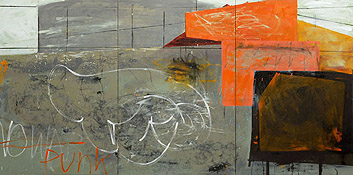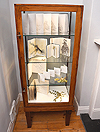
Day
Bowman: 'ZaumZone
1' (oil, charcoal & conte on canvas, 1840 x 3660mm)
Katy Macleod
Writings:
What is writing?
15 Books




Poetry
Short stories

Vitrine: The Notebook Drawings
Waste ZonesThe Water Zones ProjectThe Study Gallery of Modern Art, Poole 5 April - 15 May, 2008 Day Bowman * Ian Knox * Steve Harris (1948 – 2008) PROOF 2008 vol. 3.1 |
The Water Zones Project brings together a painter (Day Bowman), a film maker (Ian Knox) and a musician (Steve Harris) through their shared fascination with Britain's working shores, that is the industrialised and post-industrialised coastlines, 'the waste zones', as Day Bowman calls it. Day Bowman's paintings within the 'Water Zones Project' recollect what she has seen and noted in photographs of this land/seascape of “things unordered, jumbled and junked”, also the vast repositories of energy like gasometers and nuclear reactors alongside warehouses, some with ugly histories. But the way in which such sources are used does not dwell on any literal or chronicled history but serves to catch a quickened sense of what such landscapes mean as they arrest attention when passed alongside or travelled through as part of a train journey, for instance. Bowman's series of paintings, such as the 'Drums', the 'Fortresses', 'Quays' and 'Reactors' reconstruct in colour, line and form what it might be to experience the huge, looming shape of a warehouse or reactor as it is seen quickly, its hugeness and hubris registering on the nerve ends. The Water Zone paintings I viewed in Day Bowman's studio are studies (46 x 50 cms) or large scale paintings (142 x 170cms, for instance). Each clearly demonstrates the hard won skill and extensive knowledge of a painter who knows her craft and there are clear resonances back to earlier series, like the 'Compass' and 'Sandmarking' paintings of 2002-2006. However, there is also a new element in these works, of a darkened palette as in 'Fortress ST4', 2007, of dark, brooding red against black, against deadened grey. This affords a sense of the dereliction of warehouse sites or what container sites might bring with them as elicit human cargo, or, indeed, the possible dangers of the nuclear reactor. In 'Reactor 2', 2007 the vast shape of the reactor is scythed by a heavy plank of black which appears to hold down a hectic jumble of fire, an earth orange and sandy coloured haze spiralling up and into its impassive blocking out of light and space. In fact, there are no horizons in these works: they become the hugeness of the forms they recollect so that the whole canvas is taken over by them. But there is no sense of documentation or the relaying of a topographical event because each painting has its own requirements, quite separate from what has been seen. In the series of small paintings of gasometers, for instance, each is hugely filled by that recognisable and iconic cylinder container; there is simply no extraneous detail, only the exact and nuanced balance of colour, form and line. These are a series which lend an understanding of what a remembered building might mean when it becomes the subject of art: 
(Michael Horovitz from 'Sea Song' in 'Wordsounds & Sightlines', 1994 - NB dashes and spacing; see original texts p59) It is not a question of transcription or social commentary but of an acute and open sensing of a place, a time or an event by a mind made alert to that experience. The Water Zones Project, which was set up by Bowman, has afforded new possibilities for an already substantial oeuvre. This is encapsulated in a startling triptych, which at the point of writing, is untitled. It proclaims a toughened approach to what has been seen: no gestures of exuberance as in the 'Compass' series, for instance, no light palette or marking out of space as if it is also light; this triptych presents a blocking of light and a tense repression of space: three hard blocks of colour in the right hand panel, rust, black and dirt brown, one on top of the other, then dry, colour bled shapeless forms, perhaps evoking warehouses or reactors employed as the ground for graffiti which is smeared across them, the largest a huge sweep of white like a fallen, crudely nimbus cloud, the smaller a bright orange scrawl shaping the word, punk. These fragments have I shored against my ruins (T.S. Eliot 'The Waste Land', 1922) Like one of the key sources for all these current works, T. S. Eliot's 'The Waste Land', 'punk' is simply part of a landscape where loss of hope and meaning have vacuumed a space for what had not been necessary before. That is, until now Bowman's work has not employed words and although one could argue that the current use is the result of a renewed enthusiasm for Cy Twombly's work, it is also a breaking open of habits and painting conceits in response to the 'heap of broken images' seen on her coastline travels. It is also a parallel response to Michael Horovitz's poetry, most particularly to his stark deconstruction of New Labour Britain in 'A New Waste Land', his own update of Eliot's theme: 
(Michael Horovitz 'A New Waste Land: Timeship Earth at Nillennium', 2007 - see published texts p173) Bowman's triptych and Horovitz's bleak Jeremiad for the new waste land and for the broken promises of New Labour, reflect on what it is to configure loss, to allow it to haunt one's own internal landscape because that is the only place where it can begin to lay down the truth of experience. Any artist, musician or film maker knows that this marking of experience is transitory and incomplete but just as Steve Harris's lingering and dissonant sounds emerge from a musical understanding and a structuring of ideas through musical form, so Bowman's triptych, erupts within a powerfully known practice. This new work, all these works, are startling, darker, more edgy, less obviously assured. The process of their making might be like Prunella Clough's disconcerting engagement with the discarded detritus of the urban environment twenty years ago, which prefigured an intransigence within the painting itself . As Francis Bacon observed, …..the mystery of painting today is how can appearance be made. I know it can be illustrated, I know it can be photographed. But how can this thing be made so that you can catch the mystery of appearance within the mystery of making (Francis Bacon in conversation with David Sylvester, May, 1966). The structures of making are gloriously celebrated in this new collaboration of artist, musician and film maker. I have little insight into how it will work as I have only seen Bowman's paintings and heard one tape of Harris's music with the group 'Zaum' but as I know it has precipitated a tougher and more urgent set of works by Bowman, I feel sure that when it is presented, it will mark a vital event of imagining. Its envisioning of the darker aspects of Britain's coastline will be truly a celebration of imagining things differently: Redeem the time, redeem the dream (T.S. Eliot 'Ash-Wednesday', 1930)
|
| Michael Horovitz: from 'Sea Song' (Wordsounds and Sightlines, 1994) |
CV Publications  Curation & Catalogue   Links |